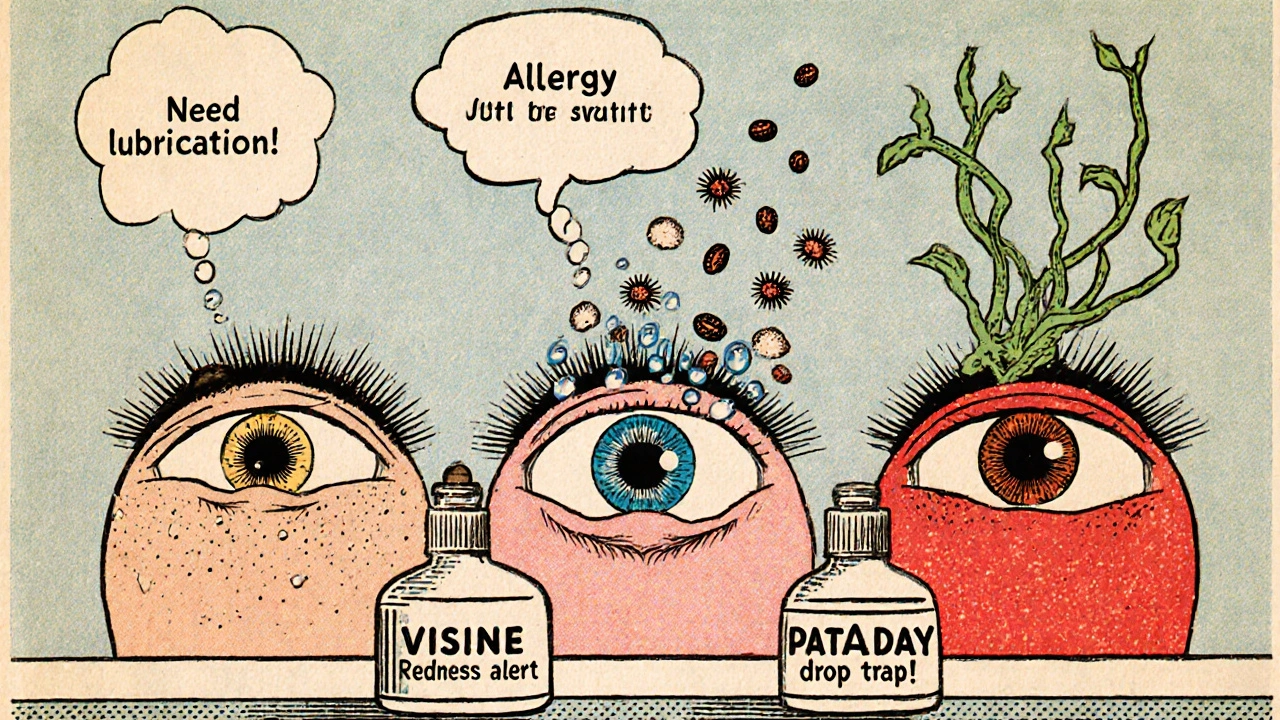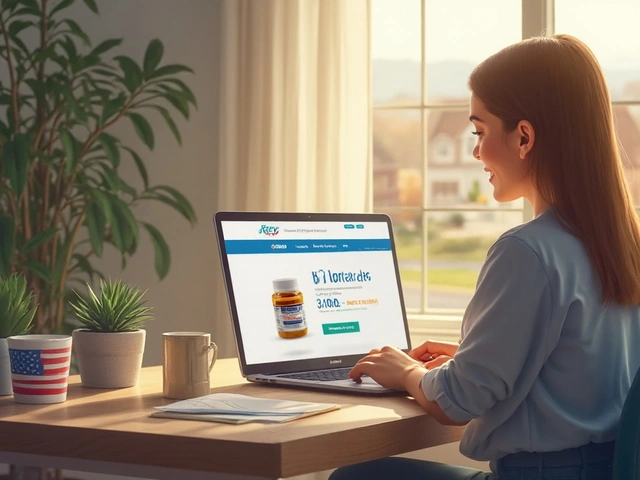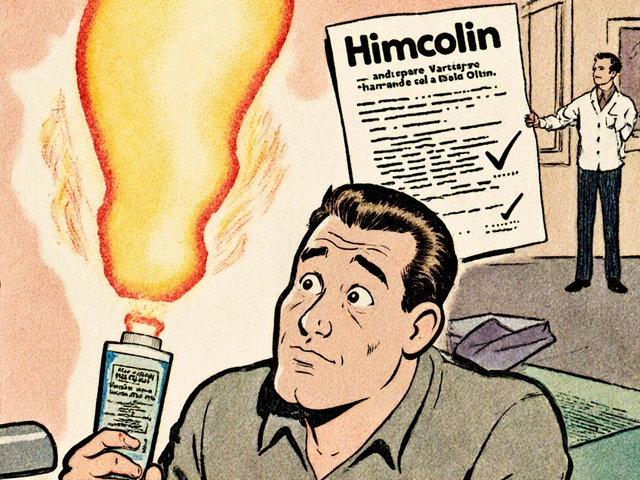Not all eye drops are created equal - and using the wrong one can make things worse
If your eyes feel gritty, itchy, or bloodshot, you’ve probably reached for an OTC eye drop. They’re on every pharmacy shelf, cheap, and seem like a quick fix. But here’s the truth: OTC eye drops aren’t one-size-fits-all. Using a redness-relief drop for dry eyes? That’s like putting gasoline on a fire. Using a lubricant for allergies? You’ll still be sneezing and scratching. The right drop depends on what’s actually bothering your eyes - not just what looks most appealing on the label.
Millions of people in the U.S. struggle with dry eyes, seasonal allergies, or chronic redness. The American Academy of Ophthalmology says over 16 million Americans have dry eye symptoms. And according to Boulder Medical Center’s 2023 patient data, 67% of those people reach for redness-relief drops first - even though those drops make dry eye worse in 83% of cases. That’s not just ineffective. It’s harmful.
Know your enemy: three types of eye discomfort - and what causes them
Your eyes are telling you something. But you need to listen closely.
- Dryness feels like sand under your eyelids. It gets worse after staring at screens, in air-conditioned rooms, or after wearing contacts. This is usually caused by not enough tear production (aqueous deficient) or tears evaporating too fast (evaporative dry eye). Both need lubrication - not decongestants.
- Allergies bring itching, watering, and swelling. They flare up with pollen, pet dander, or dust. This is an immune reaction. Your eyes release histamine. You need an antihistamine eye drop to block it.
- Redness looks scary, but it’s often a symptom, not the problem. It can come from dryness, allergies, fatigue, or even irritation from old makeup. But if you use a redness-relief drop without fixing the root cause, you’re just hiding the signal - and making the damage worse.
Here’s a quick self-check: If your eyes feel better after blinking or using a humidifier, it’s likely dryness. If they itch badly in spring or around cats, it’s allergies. If they look red but don’t itch or feel dry, maybe it’s just tiredness - and you need rest, not drops.
Artificial tears: the right kind for dry eyes
For dry eyes, you want lubricants - also called artificial tears. But not all are the same.
Standard drops like Systane Ultra or Refresh Liquigel contain ingredients like polyethylene glycol and propylene glycol. They give relief for 1-2 hours. Good for occasional use. But if you’re on a screen 8 hours a day, you need more.
For moderate to severe dry eye, look for:
- Gel drops like Systane Gel Drops or Refresh Optive GEL. They’re thicker. Last 4-6 hours. But they blur vision for 2-3 minutes after use. Best applied before bed or during breaks.
- Lipid-based drops like Systane Complete PF. These contain mineral oil and castor oil. They rebuild the oily layer on your tear film - the layer that stops tears from evaporating. Perfect if your eyes feel worse at the end of the day, or if you have Meibomian Gland Dysfunction (common in people who wear contacts or use screens a lot).
- Hypotonic drops like TheraTears. These have a lower salt concentration than your tears. They help draw water into your eye surface. Clinical data from Haas Vision Center shows they’re 37% more effective than standard drops for aqueous deficient dry eye.
- Premium biomimetic drops like Thealoz Duo. They use trehalose and sodium hyaluronate - molecules that mimic your eye’s natural repair system. In trials, they improved corneal healing by 40% compared to regular lubricants.
Preservative-free is key if you use drops more than 4 times a day. Preservatives like polyquaternium-1 can irritate your eyes over time. Single-use vials (like Refresh Optive Preservative-Free) cost more - around $12-$22 for 30 vials - but they’re safer for daily use. Multi-dose bottles last longer but carry a 22% risk of causing tiny corneal scratches with long-term use, according to Haas Vision Center.
Allergy eye drops: stop the itch, don’t just mask it
Antihistamine eye drops are your best friend during allergy season. They block histamine - the chemical that makes your eyes water and itch.
Two top options:
- Pataday (olopatadine 0.1%). FDA-approved for 24-hour relief. One drop, once a day. Works fast. 89% of users on Trustpilot say it gives all-day comfort. Great for pollen, mold, or pet allergies.
- Zaditor (ketotifen 0.035%). Generic version. Needs to be used twice daily. Slightly less potent, but still effective and cheaper.
Avoid combination drops like Bausch + Lomb Opcon-A. They mix a decongestant (naphazoline) with an antihistamine (pheniramine). They give quick relief - but 41% of regular users get rebound redness within two weeks. You’re trading short-term comfort for long-term damage.
Pro tip: Use allergy drops before exposure. If you know you’re going outside on a high-pollen day, apply the drop 30 minutes before. Prevention beats reaction every time.
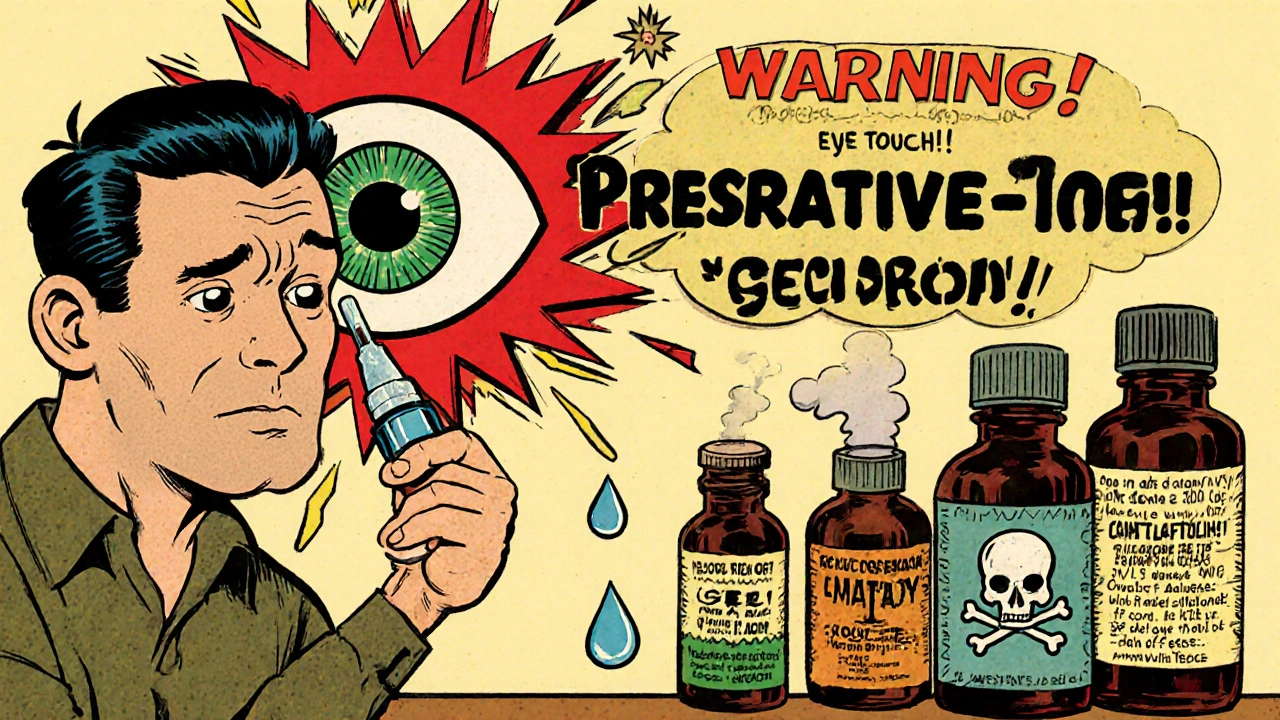
Redness-relief drops: the trap most people fall into
Visine, Clear Eyes, Lumify - these promise “whiter eyes in seconds.” They work by shrinking blood vessels. Sounds great, right?
Here’s the catch: your eyes need blood flow to stay healthy. Reducing it for hours every day starves your cornea. And when the effect wears off? Your blood vessels rebound - bigger and redder than before.
According to Boulder Medical Center’s 2023 data, 68% of people who use traditional decongestant drops like Visine (tetrahydrozoline 0.05%) develop rebound redness within two weeks. That’s not a side effect. That’s the product working exactly as designed - to keep you hooked.
Lumify (brimonidine tartrate 0.025%) is different. It targets a different type of blood vessel. Clinical trials show only 5.2% of users get rebound redness. It lasts 8 hours. But it’s not for everyone. Some report headaches. And it doesn’t treat dryness or allergies - only redness.
Bottom line: Never use redness-relief drops for dry eyes. The American Optometric Association warns they worsen dry eye in 83% of cases. If your eyes are red because they’re dry, you need lubricants - not vasoconstrictors.
How to use eye drops correctly - and avoid common mistakes
You’d be surprised how many people mess this up.
The American Academy of Ophthalmology says 68% of first-time users apply drops wrong. Here’s the right way:
- Wash your hands.
- Tilt your head back slightly.
- With one finger, gently pull down your lower eyelid to create a small pocket.
- Hold the bottle above your eye - don’t touch your eye or eyelid with the tip.
- Squeeze one drop into the pocket.
- CLOSE your eye gently for 30 seconds. Press lightly on the inner corner of your eye (near your nose) to keep the drop from draining into your throat.
- Wait 5 minutes before applying a second type of drop.
Common mistakes:
- Blinking right after - the drop just flies out.
- Touching the dropper to your eye - that’s how infections start.
- Using drops past their expiration date - even if they still look clear.
- Storing them in the bathroom - humidity and heat ruin the formula.
Most drops should be stored at room temperature. Thealoz Duo is the exception - refrigerate after opening.
What to buy - real recommendations based on your needs
Here’s a simple guide to pick the right bottle:
| Condition | Best Pick | Why | Price Range |
|---|---|---|---|
| Mild dry eye | Systane Ultra or Refresh Optive | Reliable, 1-2 hours relief, widely available | $12-$18 |
| Moderate to severe dry eye | Systane Complete PF or Thealoz Duo | Rebuilds tear film, heals cornea, lasts 6+ hours | $18-$25 |
| Dry eye with contact lenses | Blink Contacts | Designed for lens wearers, osmolarity matches tears | $14-$20 |
| Allergies (seasonal) | Pataday (olopatadine) | 24-hour relief, one drop a day, no rebound | $15-$22 |
| Redness (without dryness or allergies) | Lumify | Minimal rebound risk, lasts 8 hours | $12-$18 |
| Frequent use (4+ times/day) | Refresh Optive Preservative-Free (single-use) | No preservatives = safer for daily use | $12-$22 for 30 vials |
Don’t buy based on price alone. A $7 generic drop might cost you more in the long run if it makes your eyes worse.
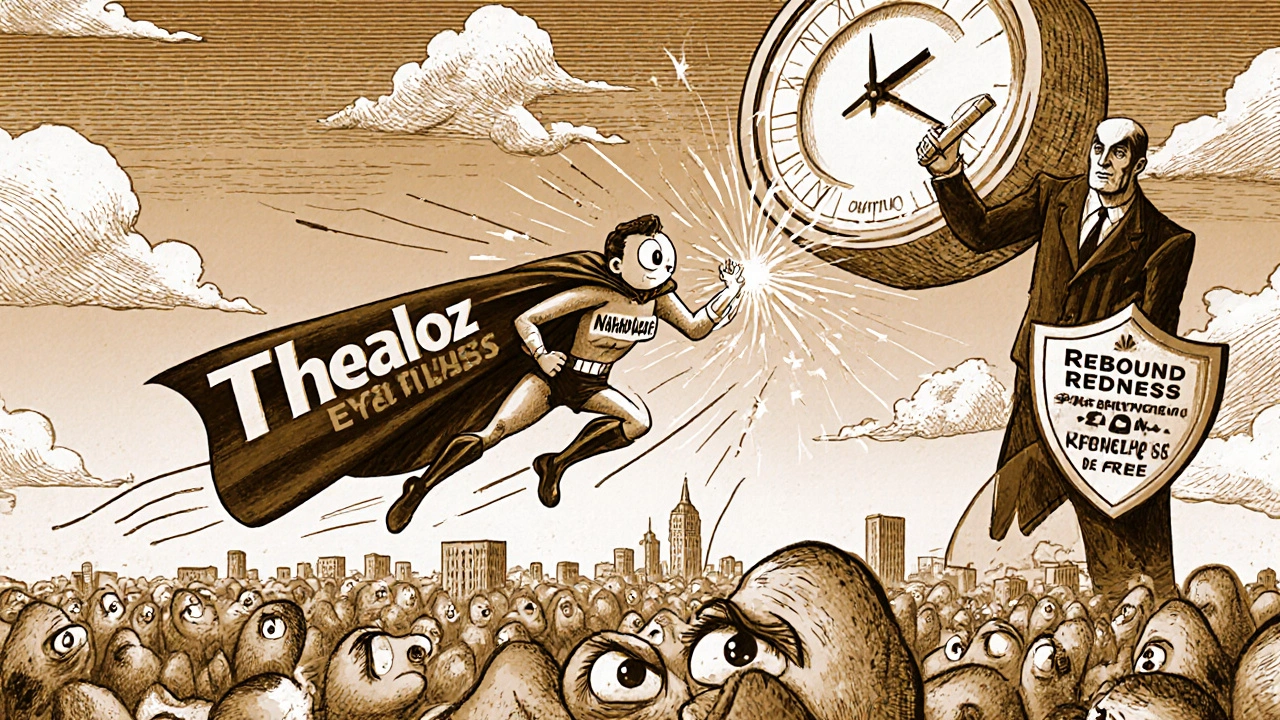
When to see a doctor
OTC drops are great for short-term relief. But if you’re still struggling after 2 weeks of using the right product, it’s time to see an eye care professional.
Red flags:
- Pain or sensitivity to light
- Blurred vision that doesn’t clear up
- Discharge or crusting on eyelids
- One eye worse than the other
- Symptoms that keep coming back
Chronic dry eye can be linked to autoimmune diseases like Sjögren’s syndrome. Allergies might need prescription immunotherapy. Redness could signal infection or inflammation. OTC drops won’t fix these.
And if you’re using redness-relief drops more than twice a week? Stop. Talk to your optometrist. You’re masking a problem that needs real treatment.
What’s changing in 2025 - and what to watch for
The OTC eye drop market is evolving. New formulas are coming out with biomimetic ingredients that actually help your eye heal - not just cover up symptoms. Systane iLux is now being paired with thermal devices for patients with Meibomian Gland Dysfunction. Preservative-free drops are growing fast - they’ll make up 35% of the market by 2027.
Also, companies are starting to track usage. Some bottles now have smart caps that log how often you use them. This helps you avoid overuse and lets your doctor see your habits.
But the biggest change? Awareness. The American Optometric Association’s “See Red” campaign, launched in January 2024, is teaching people that red eyes aren’t normal. And that using the wrong drop can do real harm.
Can I use allergy eye drops for dry eyes?
No. Allergy drops contain antihistamines that reduce itching and watering, but they don’t lubricate your eyes. If you use them for dryness, you’ll still feel gritty and tired. You need artificial tears or gel drops for that. Mixing them is fine - just wait 5 minutes between drops.
Why do my eyes sting when I put in drops?
Stinging usually means you’re using a preserved drop too often, or your eyes are already irritated. Switch to preservative-free single-use vials. Also, make sure the bottle hasn’t expired or been left in a hot car. Some people are sensitive to the pH or additives. If stinging lasts more than 30 seconds, stop using it.
Are expensive eye drops worth it?
Sometimes. Generic artificial tears work fine for mild dryness. But if you have moderate to severe dry eye, premium drops like Thealoz Duo or Systane Complete PF contain advanced ingredients that actually repair your tear film. Clinical studies show they’re 37-52% more effective. If you’re spending $100 a year on drops that don’t help, switching to a $20 bottle that works could save you pain - and money - in the long run.
Can I use eye drops with contacts?
Only use drops labeled “for contact lens wearers.” Regular drops can stick to your lenses and cause irritation or cloudiness. Blink Contacts and Refresh Contacts are designed to match your eye’s natural salt balance. Always remove contacts before using gel drops - they’re too thick and can warp your lenses.
How long do OTC eye drops last after opening?
Most multi-dose bottles last 28 days after opening - even if the bottle says “use by” a year later. That’s because preservatives break down over time, and bacteria can grow. Single-use vials are good for one use only - throw them away after you use them. Never save them for later.
Is it safe to use eye drops every day?
Yes - if you’re using the right kind. Lubricating drops and antihistamine drops are safe for daily use. But avoid redness-relief drops (like Visine) more than twice a week. And if you’re using more than 4 drops a day, switch to preservative-free versions. Chronic use of preserved drops can damage your eye surface over time.
Final tip: Your eyes are not disposable
They’re one of your most important senses. Don’t treat them like a problem to be sprayed away. If you’re using eye drops regularly, you’re managing a condition - not just a symptom. Pick the right one. Use it correctly. And if things don’t improve, don’t keep reaching for the same bottle. See someone who knows what they’re doing. Your vision is worth more than a $10 bottle.
